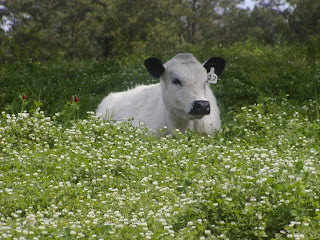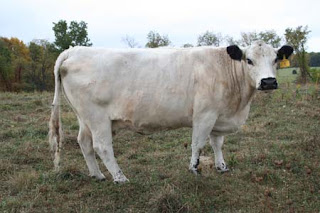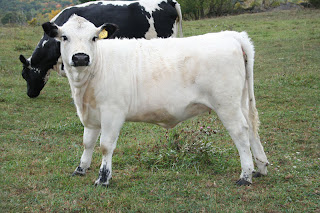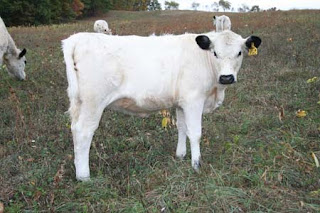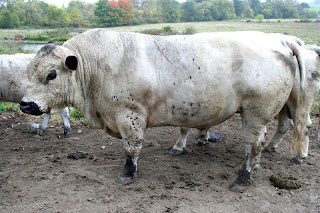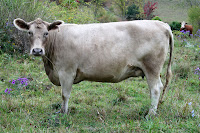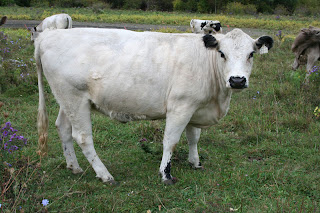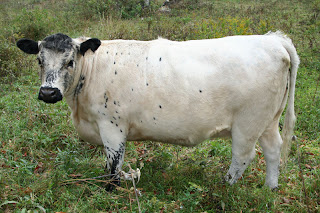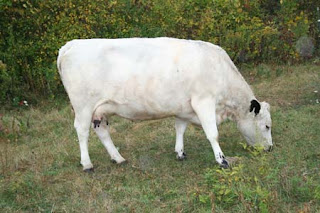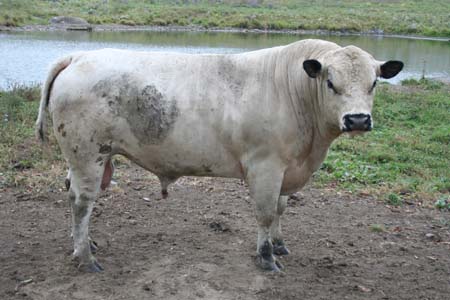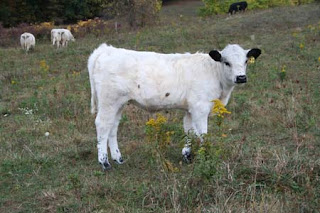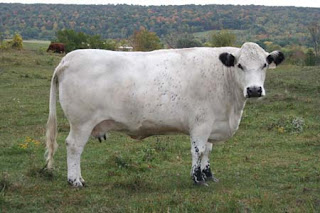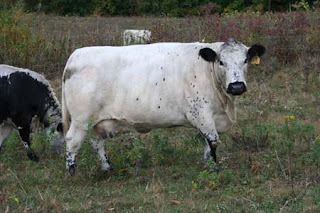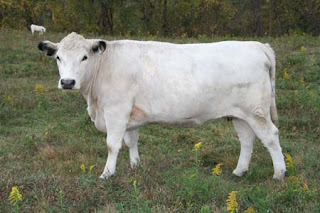Update July 2012: Semen on J.West's El Presidente and J.West's Elvis is now available for export to Colombia and other South American countries.
See the link above for additional information.
 |
| Blanco Orejinegro Heifer - Beautifully Feminine |
Some time ago I was fortunate to begin a correspondence with Jorge Elias Angel, a breeder of the endangered Criollo cattle breed, Blanco Orejinegro (BON), in the beautiful country of Colombia. Jorge Elias has provided me a grand collection of photos of this Colombian heritage breed, and most of the photos you find in this blog come from his herd of Colombian BON cattle unless otherwise credited. All photos can be clicked to a larger more viewable size.
 |
| Jorge Elias Angel and his little daughter, Luciana |
Jorge Elias Angel is a small producer of the Blanco Orejinegro breed, and working with them has led to a great love and passion for these unique, gentle and hardy cattle. I hope readers find this exploration of the Blanco Orejinegro breed both enjoyable and informative.
The BON cattle are white with black ears, which is precisely what their breed name, Blanco Orejinegro, means. And like polled and horned Park cattle, Colombia also has a variety of the breed referred to as Blanco Orejimono, and these cattle are white with red ears.
The ancestral basis of the breed dates back to the introduction of European cattle by Christopher Columbus to various parts of the Americas over the course of several expeditions from Spain beginning in 1493. "The first documented arrival of livestock into current Colombia dates from 1523 when conquistador Rodrigo de Bastidas brought 200 cattle, 300 pigs, and 25 horses from Spain to the Caribbean port of Santa Marta (PINZON MARTINEZ 1984 )".
(1)
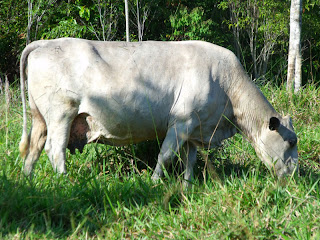 |
| Blanco Orejinegro Cow - A Fine Looking Female |
The BON breed evolved from this imported European cattle stock on the slopes of the Colombian Andes, “. . . where the northern winds that originate in Canada die out as they sweep south across the Gulf of Mexico and the Caribbean to dissipate their moisture against the first solid obstacle of mountains, the north face of the Colombian Andes.”
(2, Dr. Jorge de Alba)
 |
| Blanco Orejinegro Bull from Colombia's BOHEMIA herd, established by Felipe Buitrago, and one of largest and most respected BON breeding herds in Colombia - This bull could easily be mistaken for a British White bull here in the USA - and would likely be in high demand as an AI sire. |
Dr. Alba further tells us that “. . . these intricately woven mountains were taken over by the very fast expansion of coffee growing in the early 19th century. This brought wealth and purchasing power to a scattered population in the Departments of Antioquia and Caldas. Commerce developed before the coming of the railways . . . mules were scarce, so the Blanco Orejinegro was trained as a beast of burden and its appreciation rose in the eyes of the whole population since other cattle could not carry any loads if their backs, or sides at the rib cage were covered with Nuche sores.”
 |
| Historical Photo of Blanco Orejinegro Oxen, circa 1930 |
The Nuche is a regional skin-burrowing parasite that thrives in tropical rainforest areas and plagues dark haired cattle breeds, causing damage to the leather as well as the health of the cattle infected. This parasite is the
Dermatobia Hominus, known commonly in the USA as
the Botfly, and is highly prevalent in Colombia and Latin America.
Studies have documented that the BON cattle breed has significantly less incidence of infestation with the Botfly, and this is directly attributed to the white coat color of BON cattle and perhaps to the thickness of their hide as well, although the focus in the linked study above is coat color providing the Nuche/Botfly resistance.
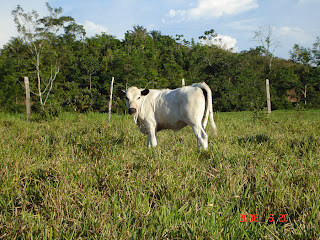 |
| BON Calf Grazing Colombian Pasture |
As for the disposition of BON cattle, most descriptive references you find of the BON breed describe them as
docile, and Dr. Alba’s work reflects this as well, as he goes on to tell us in regard to their use as oxen -- “The surefootedness of the Blanco Orejinegro, and docility made them ideal for the purpose.”
I asked Jorge Elias Angel about the disposition of his BON cattle, whether he was able to approach the newborns without fear of their dams, walk among the cow herd without them scattering to the four winds, etc…
Jorge Elias said, “Yes, that is one of the great things . . . they are extremely docile. You can approach them without risk, even when they have just given birth, the problem is to catch the newborn, because they are very awake (alert) . . . they will stand up and run away a few minutes after they are born, and they also have all their teeth.” Jorge also said, “They are one of the most fertile breeds here in Colombia, they are very maternal, calm and docile.”
 |
| This is Estrellita, or 'Little Star', an early March 2011 Blanco Orejinegro newborn. British White calves are known to be on their feet and scampering around within an hour or so of their new life - which is quite unlike most calves of registered cattle, or calves born in USA commerical cattle herds -- but it is something else they have in common with the Blanco Orejinegro of Colombia! |
And in regard to their hardiness and disease resistance, Jorge Elias tells me:
“BON cattle had to survive in a very hard environment . . . In all these years they had to deal with high mountains, poor grass, natural enemies, etc…, and those things have made this breed possess a high, natural genetic resistance to several diseases, like brucellosis, foot and mouth disease, IBR and external pests like ticks.”
So we have a hardy, disease resistant, very fertile and maternal, docile white cow with black or red ears that was an historic dual purpose animal -- a giver of milk and meat, and a beast of burden. Sound familiar? Yes, it is hard to miss the descriptive similarities -- this is the well described and documented ancient historical traits of both the polled and horned Park cattle of the British Isles.
 |
| Blanco Orejinegro Yearling Heifer |
Besides some differences in general conformation from the polled British White today, which you can observe in these various photos, a very distinguishing difference between the evolved and adapted BON of Colombia and a British White cow in my pastures today
is their hide.
The work of Dr. Jorge de Alba tells us that “. . . the Blanco Orejinegro possess the strongest, tightest, toughest and thickest hide known to the author in any bovine.” Now that is a strong statement, and certainly a valuable trait to be perpetuated and protected from loss in any cross-breeding decisions with other cattle breeds. Dr. Alba goes on to describe the hide as “totally pigmented jet black”, and Jorge Elias Angel says the young calves are actually born with pink skin, and that much of the skin pigment darkens to black by the age of about two years -- the skin darkening seems to be in response to the rays of the sun.
 |
| Bull from Felipe Buitrago's BOHEMIA herd of BON cattle |
Within some historic polled Park cattle (British White) herds in Britain, there is a very long tradition of choosing a fully blue/grey skinned bull as herd sire if available, and it was my impression from my visit to various British herds some years ago that it is not as common to have a blue-skinned bull born as it once was in bygone days.
Based on my own breeding experiences, choosing a blue/grey-skinned British White bull seems to ensure very strong black color in all the sun sensitive mucus membrane areas of their offspring -- certainly better assures that desirable
'ink-dipped nose' and heavily mascaraed eyes that generally have as well a dark eyebrow – and can result as well in more black spots or speckling in the torso of their offspring.
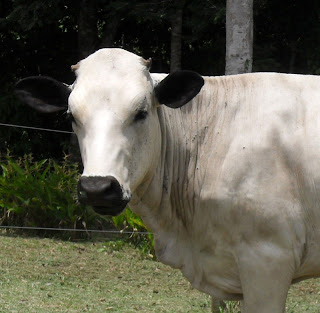 |
| Blanco Orejinegro Female |
Clearly the use of the best dark skin pigmented bulls in the BON breed, and those with a healthy amount of black spotting or speckling, results in a higher degree of desirable protective dark skin pigmentation, but evenso there are largely white furred calves born as their offspring -- the colored speckling occurring, but embraced, rather than discounted as undesirable. As in the olden days in Britain -- the dark skinned bull, which generally will have a higher degree of dark spots or speckles -- gives the better, more hardy, calf crop.
In Colombia, as opposed to British White purist breeders who do not understand that spots of color and speckling are natural manifestations of the breed's genetics, there are some breeders who much admire the BON cattle that are heavily speckled, as we are told by Dr. Jorge de Alba:
“There is a variety called "Azul Pintado" much favoured by some Colombian breeders which has abundant "flea bitten" small black spots giving the bluish appearance. . .”
In March of 2008 I wrote another
blog about the BON breed, and a review of that blog this morning reminded me that even then I was struck by the possible kinship of the ancient Park cattle of Britain and the BON breed. We all can readily accept the genetic potency of what is known in the scientific community as the White Park color pattern -- but what is not yet identified scientifically is the
heritable docility that would appear to pass along with this color pattern. Nonetheless, I have seen its strength myself in crossing my British Whites with high strung black Angus cattle – the offspring were without fail much nicer to be around.
 |
| Blanco Orejinegro Calf - Dibujo |
A glance back at the many references to white cattle with black or red ears within the ancient Celtic oral and written histories of Europe makes it clear that the unique markings of British White cattle, milk white with red or black ears, were well present and much revered since the beginning of recorded history, and they are clearly quite tame cattle easily milked and herded -- easily led to slaughter.
The color pattern, white with black or red points, is found in an interesting assortment of
very old breeds of cattle across the world, many of which are described as docile; and I have often hypothesized to myself that the geographic occurrence of these white, docile, and revered old breeds bore some significance to the
migratory patterns of ancient humanity.
 |
| BON Cow with Speckled Red-Eared Calf |
It is from the Celtic region and culture of Europe that we find the most ancient recorded references to the milk white cattle. But, when one explores history and the known migration patterns of ancient peoples, and as well the pattern of today’s existing geographic occurrence of heritage white cattle breeds with black/red points – it becomes a worthwhile hypothesis that these ancient revered milk white cattle were part of those migrations and left their imprint throughout their travels with their herds-keepers.
It has long been known that genetically the color pattern of Park cattle is above the actual color genetics of a cow in the DNA chain; thus, a homozygous black cow bred to a Park bull will be highly likely to have a white calf with black ears, a homozygous red cow a white calf with red ears. So as humans migrated from different points, whether it was Africa or the East, or even the migrations of the indigenous peoples of the Iberian Peninsula (modern day Spain)
(3) -- the white cattle with black points had ample opportunity to replicate themselves and leave offspring behind in various regions.
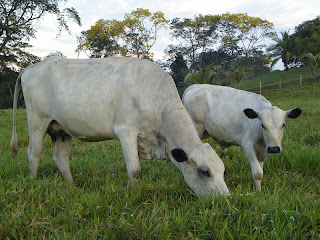 |
| Blanco Orejinegro Cow/Calf Pair |
Given that the color pattern is so potent genetically, the mixing of the white cow with colored points with other cattle in various regions led to geographically differentiated breeds that are white with colored points. Over thousands of years the unique characteristics of particular white breeds developed their modern breed traits through selection, survival, and environmental adaptation that reflected their geographic location --
the Blanco Orejinegro clearly being an excellent relatively modern day example – the BON’s evolved singularly thick, tough and dark hide being a requisite for survival in the Colombian Andes where the sun is hot most of the time, and the ‘Nuche’ always waiting to burrow into their skin and propagate.
The Blanco Orejinegro is part of a group referred to as Criollo breeds in Latin America, and would be considered a somewhat modern day example of an animal’s ability to adapt to geographic location fairly quickly – a mere 400 years or so being a blip in time. “The term "Criollo" has been used since early colonial times in Latin America in reference to both people and animals born in the newly-discovered land from imported parents.
(2)
 |
| Stock Photo of the White Caceres/Cacerena of Spain |
As already mentioned, the imported parents of the modern day Blanco Orejinegro, or BON, cattle breed, has been traced to the expeditions to the Americas of Christopher Columbus from the coast of Spain. A limited search for ancient white cattle breeds in Spain finds the
highly endangered White Caceres, also known as the Blanca Guadianese and the Blanca Cacereña. The White Cáceres was developed in the region surrounding Extremadura in western Spain. In this photo, there is a hint of a reddish nose and possibly red on the ear of this breed, and they retain a lyre shaped horn, which was the original characteristic of the ancient horned Park cattle, now quite varied due to documented cross-breeding with other British horned breeds in the 19th and early 20th centuries. Follow
this link for a very old photograph of a Chillingham Park bull -- it looks amazingly like the White Cacerena bull pictured below.
Historically, the city of Caceres in the region of Extremadura, is known to have played a role in the early settlement of the Americas:
"Cáceres flourished during the Reconquista and the Discovery of America, as influential Spanish families and nobles built homes and small palaces there, and many members of families from Extremadura participated in voyages to America where they made their fortunes." (4)
There is a 2010 photo of a white cow at pasture in Extremadura found on
elaineintherain.blogspot.com, and the blurb with the photo indicates some relationship with the expeditions of Columbus, as well as this photo of a White Caceres bull found in
this conservation article -- both photos reflect very faint reddish coloration to the nose and ears. No doubt this old Spanish breed sailed with Colombus in the early 16th century, and may well be a component of the parent stock of Blanco Orejinegro. For a truly spectacular photo of a Caceres cow/calf pair, see
soscaballolosino.com.
 |
| BON Cow with Newborn Calf - Note the Abundant Milk |
Whatever their actual European genetic base, be it a kinship with the ancient Park cattle (
which seems absolutely the most likely predominant parent stock) or another unrelated white cattle breed of Spain -- BON cattle evolved and thrived in Colombia from the early 16th century until the latter part of the 19th century, when the riches from coffee production led to the introduction of other cattle breeds presumed superior, and the subsequent usurpation of the BON’s dominant position in the region.
Sadly, it only took about 100 years of introducing other cattle breeds to the area to see the decline of this white Criollo breed that so well adapted itself in the Colombian Andes. The BON cattle are now endangered, and through the efforts of many breeders, such as Jorge Elias Angel, the breed is being revived and its clear superior ability to thrive in Colombia once again in focus.
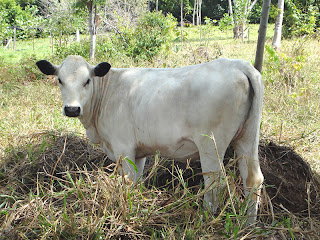 |
| Blanco Orejinegro Heifer |
In the United States, there is much importation of the more volatile white Brahman cattle semen, as well as the white Nelore cattle breed for improvement of the hardiness of American cattle. Given the tough dark hide, the disease resistance, the fertility and the docility of the Blanco Orejinegro –
this endangered Colombian heritage breed well deserves the focus and attention of North American cattlemen today!
Related Links:
 |
| A Natural Cascade on the Colombian Farm of Jorge Elias Angel |
Columbia Tourist Information
Blanco Orejinegro Cattle for Sale
Criollo Cattle of Latin America, by Jorge de Alba, FAO Corporate Document Repository
Parasitism “nuche” fly (Dermatobia hominis) in Colombia
Black Irish (Spanish heritage) - Wikipedia
IMPORTANT NOTE: Any use of these photos by others must be credited to the Colombian BON herds of Jorge Elias Angel or Felipe Buitrago, unless otherwise noted in the captions.
Footnotes:
(1)
Abundant mtDNA Diversity and Ancestral Admixture in Colombian criollo Cattle
(2)
Criollo Cattle of Latin America, by Dr. Jorge de Alba, FAO of the UN Document Repository
(3) “The primary genetic legacy of Ireland seems to have come from people from Spain and Portugal after the last ice age.” said McEvoy. They seem to have come up along the coast through Western Europe and arrived in Ireland, Scotland and Wales. Source:
The Irish – more Spanish than Celtic?
(4)
Cáceres, Spain - Wikipedia
(5)
Genetic characterization of landraces and Romosinuano BON - New Link Added
Below is a photo of a contented Blanco Orejinegro cow in Jorge Elias Angel's BON herd that is 9 months bred, a few days away from calving. She is the very pretty dam of the March 2011 newborn calf, Estrellita, pictured above in this blog, and she will clearly give much milk to the newly born 'Little Star'.















